Creating 3D FEFLOW Models
This feature is only available with the Hydrogeology extension.
3D FEFLOW model can be created in Leapfrog Geo with layering defined by a geological model. This topic describes the process of creating a 3D FEFLOW model in Leapfrog Geo, then adding features. It is divided into:
In versions of Leapfrog Geo before 2021.2, creating a 3D FEFLOW model required that a 2D FEFLOW grid be created first. A 2D grid is now automatically created as part of the process for creating a 3D grid. When older Leapfrog Geo projects are upgraded that contain 2D FEFLOW grids, the existing 2D grid will be moved into the 3D FEFLOW grids that are dependent on them. This means:
- When a 2D grid is used as the basis of multiple 3D FEFLOW grids, the 2D grid will be copied for each 3D grid.
- Any 2D FEFLOW grids that are not linked to a 3D FEFLOW grid will remain in the project as a separate object but cannot be used as the basis for a 3D FEFLOW grid.
Creating a New 3D FEFLOW Model
To create a new FEFLOW model, right-click on the Hydrogeology folder and select FEFLOW > New Model. The New FEFLOW Model window will appear. In this example, a geological model has been added to the scene to aid in defining the FEFLOW model:
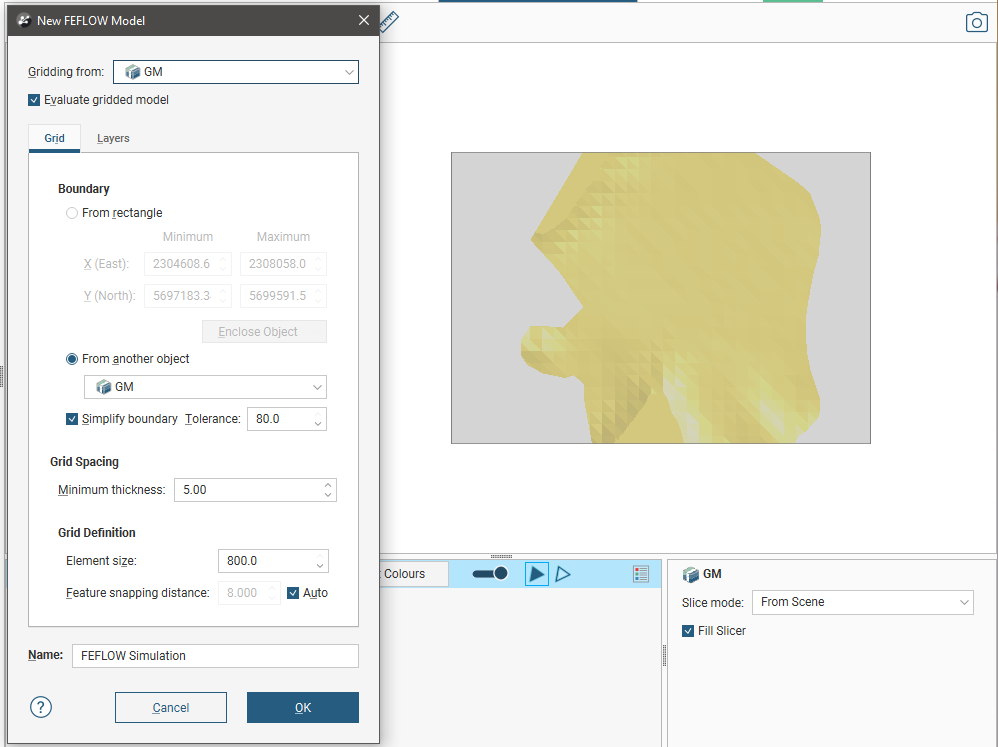
The Gridding from setting determines the geological model used for layer guides. Ticking the Evaluate gridded model box will evaluate the new 3D model against the selected geological model and set it as the evaluation for export. See FEFLOW Evaluations for more information. If you do not wish to evaluate the geological model on the grid, untick the box. You will still be able to use the layers in the geological model to control the grid layers.
Once the model has been created, you can change most of its settings, but you will not be able to change the Gridding from model.
Click on the Layers tab to see the layers that will be used in the new 3D model. By default, the layers from the Gridding from model are selected as layer guides, but you can change this by clicking the Select layer guides button and changing which layers are used:
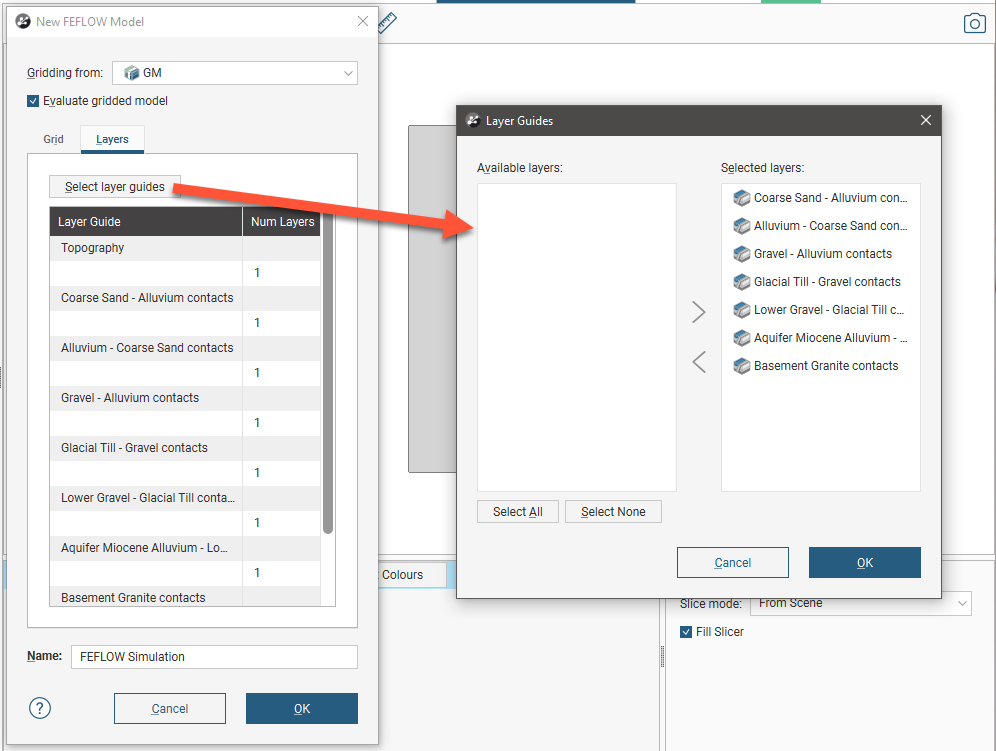
If the grid is required to follow a geological model lithology contact surface, move the layer into the Selected list and it will be honoured in the gridding process.
Once you have determined which layers you will use as layer guides, you can change how many layers there will be in the 3D model. To do this, click on a layer in the Layers tab and edit the Num Layers value:
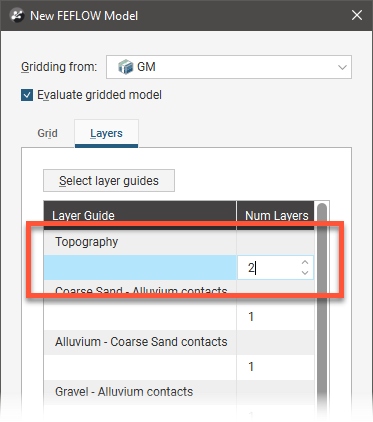
The minimum thickness of each layer is determined by the Minimum thickness setting in the Grid tab. If there is a conflict between the Minimum thickness setting and the number of layers defined in the Layers tab, Leapfrog Geo will display an error message when you click the OK button to create the model.
In the Grid tab, the model’s boundary can be defined as a rectangle or from another object in the project. In the example above, the geological model GM is used to define the FEFLOW model’s boundary. When the boundary is set to From rectangle, controls will appear in the scene that will help in setting the boundary:
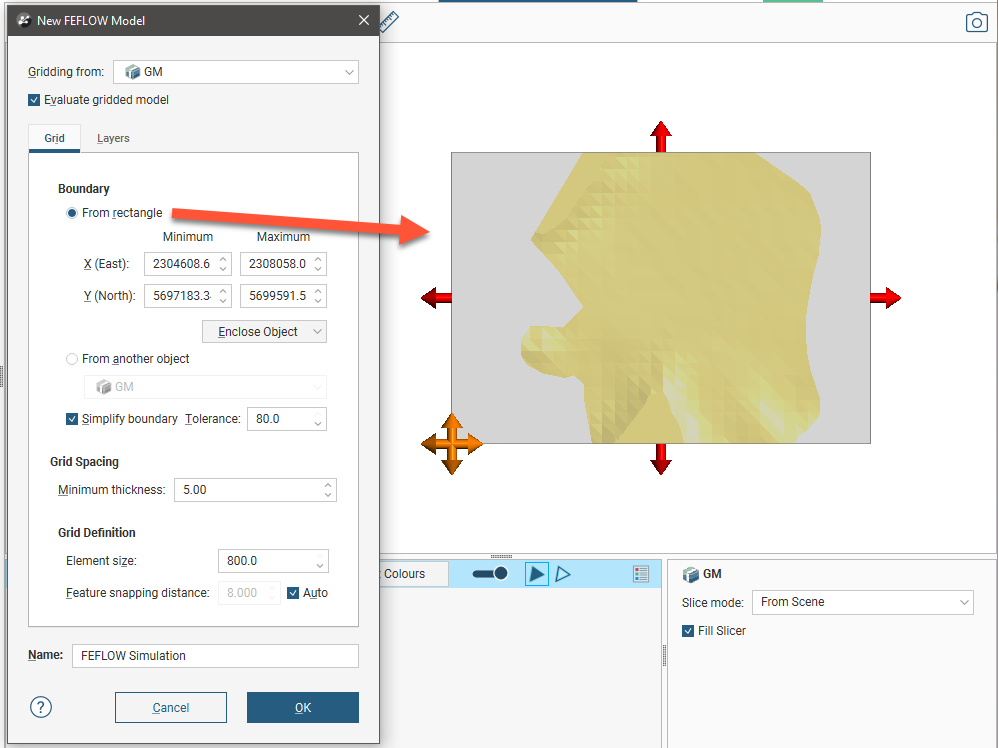
The boundaries of the Gridding from model must be larger than the boundary of the new FEFLOW model.
When the boundary is set from another object in the project, the Simplify boundary option can be used to reduce the number of points along the boundary. A lower Tolerance value increases the number of points along the boundary. The two settings together let you define a basic boundary with elements that are roughly uniform in size, set by the value of Element size. Here, a grid has been created from a geological model with the Simplify boundary option enabled:
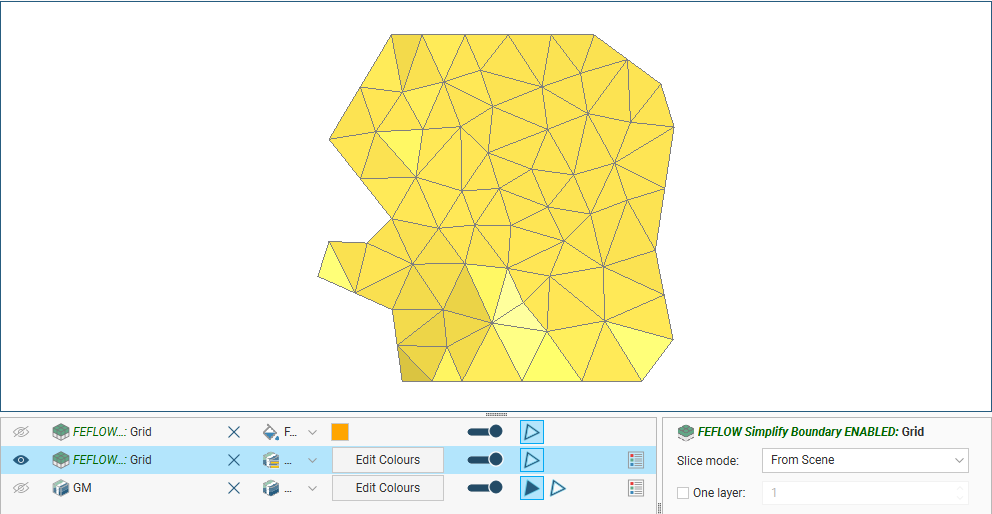
Disabling the Simplify boundary option results in more detail around the edges of the grid:
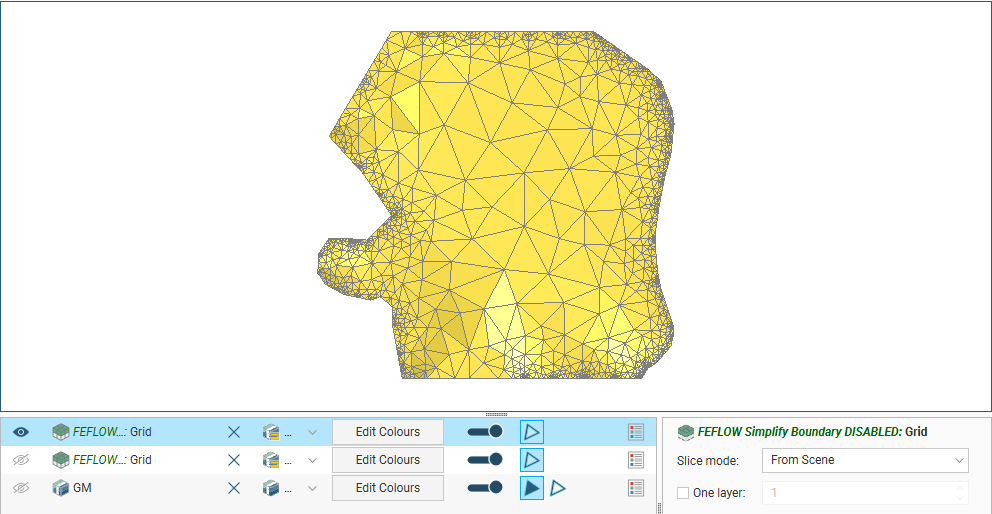
The Element size setting determines the basic size of the triangles that make up the grid, although the size will vary according to features applied to the grid and the Feature snapping distance. The size will also vary if the Simplify boundary option is unticked, in which case the Element size setting is the maximum size of the triangles.
The Feature snapping distance is automatically set to 1 percent of the Element size. To use a smaller snapping distance, untick the Auto box and set the value required.
The effects of the Feature snapping distance do not become apparent until features have been added to the grid, after it has been created, which is described in Adding Features to the Grid below.
Click OK to generate the new FEFLOW model, which will appear in the project tree under the Hydrogeology folder.
Editing the Model
In the project tree, the FEFLOW model is organised into a 3D grid object (![]() ) that contains a 2D grid (
) that contains a 2D grid (![]() ):
):
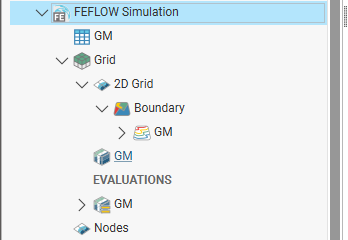
To edit model settings such as the boundary, layer guides, Minimum thickness, Element size and the Feature snapping distance, double-click on the 3D grid object (![]() ). The geological model used for gridding cannot be changed.
). The geological model used for gridding cannot be changed.
Adding features to the grid involves working with the 2D grid, which is described in Adding Features to the Grid below.
Adding Features to the Grid
You can refine the resolution of the FEFLOW model by adding features to it around objects about which you have more information, such as drilling data.
To add features to the FEFLOW model, expand it in the project tree, then right-click on the 2D grid object (![]() ) and select New Feature.
) and select New Feature.
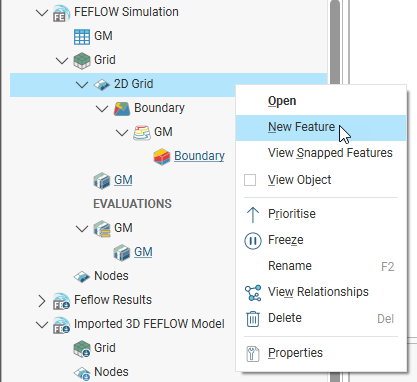
In the window that appears, you can add points, lines and polygons to the model. Click the Select button to view the objects in the project that can be added to the model. If an object has query filters defined, you can filter the data, if required.
Select the object you wish to use, then click OK to return to the New FEFLOW Feature window.
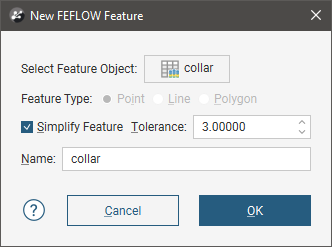
For many objects, the Feature Type setting will be automatically determined, but for polylines, you can select the Feature Type.
Ticking the Simplify Feature option will reduce the number of points used, with a lower Tolerance value increasing the number of points along the boundary.
Once you have added a feature to the grid, you can edit the Simplify Feature/Tolerance settings, but you cannot change the object used or switch to a different query filter.
Click OK to add the feature, which will appear in the project tree under the 2D grid object:
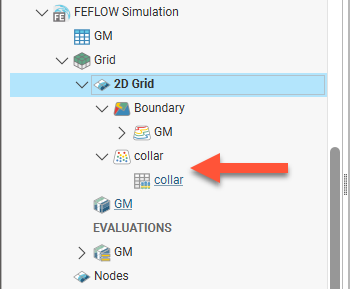
You can edit the feature by double-clicking on it or by right-clicking on it and selecting Open. In the Edit FEFLOW Feature window, you can enable or disable the Simplify Feature setting and change the Tolerance.
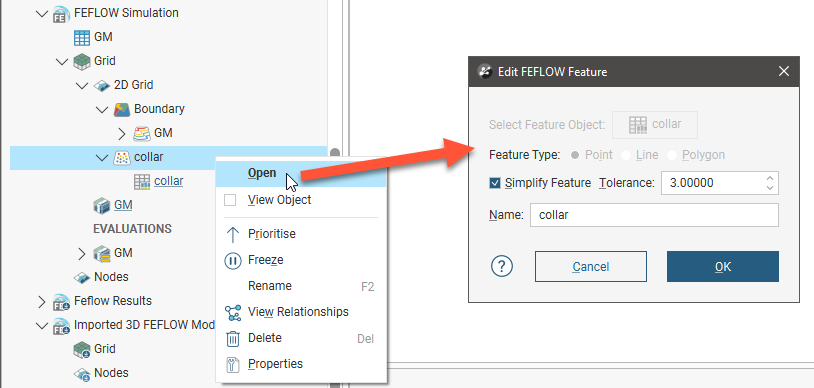
To view all features that have been applied to a FEFLOW model, double-click on the 2D grid object (![]() ). This opens the Edit 2D FEFLOW Grid window with the Features tab open, showing all features that have been added to the grid:
). This opens the Edit 2D FEFLOW Grid window with the Features tab open, showing all features that have been added to the grid:
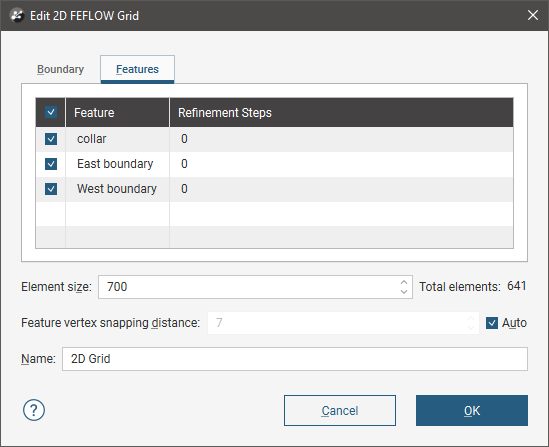
You can set Refinement Steps on a feature-by-feature basis. More steps will produce more detail near the feature.
If you want to modify a feature without having to reprocess the grid, untick it in the Features tab. If you want to delete a feature, right-click on it in the project tree and select Delete.
The images below show a grid displayed with collar points (in red) to demonstrate the effects of no features and collars applied with different refinement steps:
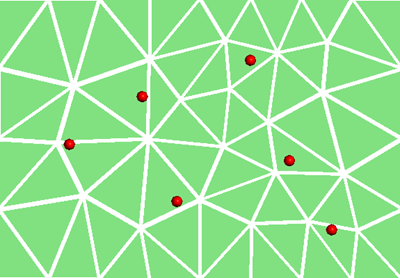
|
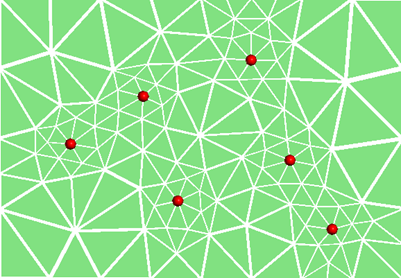
|
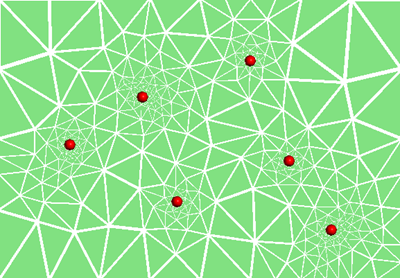
|
| No features | Collars with 2 refinement steps | Collars with 10 refinement steps |
To view all features added to a grid, right-click on the grid and select View Snapped Features. A Snapped Features object will appear in the shape list that represents all objects used to add features to the grid:
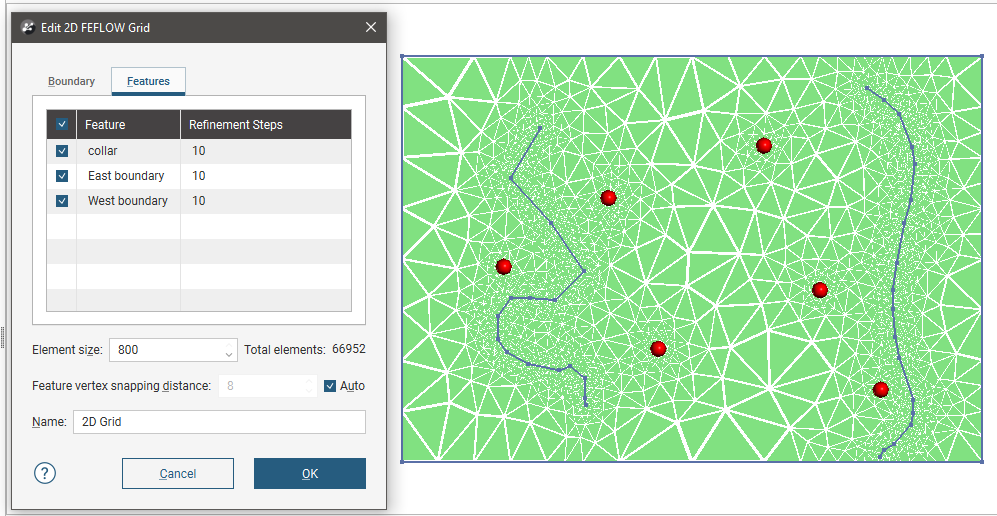
Here, four snapped objects appear in the scene: the three features listed in the Features tab and the grid’s boundary.
Got a question? Visit the Seequent forums or Seequent support
© 2022 Bentley Systems, Incorporated